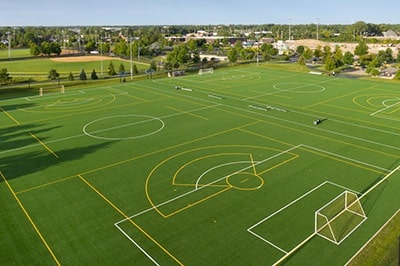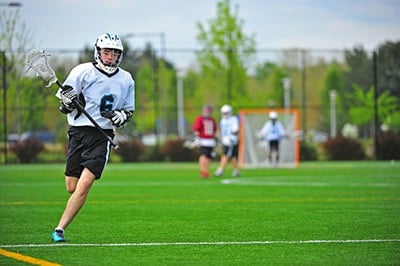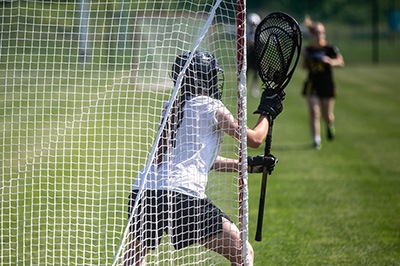If you want to know more about field lacrosse, this guide is the best for you!
The expert covers all basics and crucial parts to remind professionals and teach rookies. You can find multiple instructions and information, including:
- Field lacrosse as a modern sport
- Game play rules
- The object of the sport
- Equipment requirements
- Lacrosse field dimensions
- Sports history, and so much more
So, if you're curious about the sport and want to try it, read below to find all the answers to your questions.
More...
Take away key points:
The sport might seem too complex initially, but once you understand all its parts and basics, playing lacrosse will be a breeze. Let's summarize the basics together.
What is field lacrosse?

Field lacrosse is a full-contact outdoor men's sport. It requires ten players on two teams competing against each other. Lacrosse originated among Native Americans, but the modern rules date back to 1867 when Canadian William George Beers established the basic game system.
Men's lacrosse is one of the three main versions of the game. The other two versions include:
- Box lacrosse - originated in the 1930s.
- Women's field lacrosse originated in the 1890s.
All three versions have their rules, but their stem is pretty much the same.
The object of the lacrosse field game
The main goal is to use field lacrosse to catch, pass, carry and shoot a lacrosse ball into the opponent's goal.
Lacrosse teams use specific sticks with triangular heads to help them catch and carry the ball. Lacrosse players who score more goals are the winners.
History of the field lacrosse
As a game, lacrosse dates back to Native Americans. They used it to celebrate the Creator, with games lasting for several days, with up to 1,000 players.
With the Europeans conquering the Natives, the game got its name, originating from a French word for the stick.
Finally, in 1867, a man called William George Beers modified the basics, and presented the modern version of lacrosse, played worldwide.
In a book called Lacrosse: The National Game of Canada, Beers presented the rules for lacrosse ball dimensions, number of lacrosse players, specified field layout, lacrosse stick length, and number of goals required to determine the match winner. Beers also established the Canadian Lacrosse Association.
However, the rules were changed in the 1930s, when the number of players was reduced from twelve to ten, the field was shortened, and protective equipment was established.
Field lacrosse rules
Lacrosse includes two opposing teams competing to shoot the ball into the opposing team's goal. Lacrosse teams consist of ten players on the lacrosse field.
The players include:
Rules indicate that all players must wear specific protective equipment and a specific lacrosse stick, meeting the dimension requirements. However, the rules also establish allowable activities, boundaries, and the length of the game. If players transgress the regulations, officials assess the penalties.
US lacrosse field dimensions
Standard NFHS lacrosse field dimensions measure 110 yards (100 meters) from each end line and 60 yards (55 meters) in width from the sidelines. The lacrosse field is slightly larger than the football field.
Goals are placed between each sideline, positioned 15 yards (14 meters) from each end-line and 80 yards (70 meters) apart from one another. Goals are 6x6 feet (1.8x1.8 meters), and their positions within the end lines allow the game to occur behind them.
The net is attached in a pyramid shape. Each goal is surrounded by a circular area - a crease. The crease measures 18 feet (5.5 meters) in diameter. If a player enters the crease while shooting toward the opposing team's goal, the referee calls a foul and returns the ball to the other team.
The lacrosse field has a specific pair of lines, 20 yards (18 meters) from each goal line and midfield line. The lines divide the field into three parts.
READ MORE
How to play lacrosse field game?
From the team's point of view, the sections have the following order:
1. Defensive area
2. Midfield area
3. Attack/offensive area
These separating lines are known as restraining lines.
A right angle line is marked by ten yards (9.1 meters) from the sideline and connects each end line, creating the restraining box. The restraining box keeps the ball inside and avoids a loss-of-possession penalty.
Namely, suppose a referee or other official determines that one team is "stalling" (not attacking with offensive purpose while controlling the ball). In that case, the possessing team must keep the ball within the offensive restraining box.
Positional rules
Men's lacrosse player positions are determined by field markings during a face-off. There are six lacrosse players (without goalkeepers) in each of these areas, defined by the restraining lines.
Three midfielders from each team occupy the midfield side, and three offensive players and three defenders from the opposing team occupy each offensive area. The players must remain within the areas until the ball crosses either the restraining line or until the midfielder gains possession.
Wing areas are marked on the lacrosse field on the midfield line 10 yards (9.1 meters) from each sideline. The line indicates where the two non face-off midfielders per team line up during a face-off situation. For example, these field players might position themselves on either side of the midfield line.
Two players will lay their sticks horizontally next to the ball in the face-off. The stick's head is inches from the ball, and the butt-end points down the midfield line.
Once the referee blows the whistle to start play, the midfielders scrap for the ball to earn possession. Then, the other midfielders advance to play the ball. If the face-off player wins the possession, he may move the ball himself or pass to a teammate.
The rules also require that substitution areas, a coaches area, a penalty box, and team bench areas be designated on the field.
Lacrosse field required equipment
The lacrosse equipment includes a lacrosse stick and protective playing gear, such as:
- lacrosse helmet with a face mask.
In addition, a lacrosse player must wear an athletic supporter with a cup pocket, mouth guards, and a protective cup. However, the rule changes in the PLL, so the players don't need to wear shoulder pads.
Players carry their long sticks or short sticks. The term long/short stick is also changed into a pole, so you can often hear the latter term.
A short stick measures 40-42 inches, while long sticks measure 52-72 inches. Four players use long sticks per team: one midfielder and three defensemen.
The sport's growth has been obstructed by the cost of a player's equipment: helmet, hand protection, uniform, shoulder pads, and lacrosse sticks. Most players have a minimum of two lacrosse sticks for use in any contest.
Players used different sticks made by Native American craftsmen. These were expensive and even hard to find. The introduction of plastic heads in the 1970s gave players an alternative to a wooden stick, and mass production enabled the growth of the game worldwide.
What are field lacrosse positions in the lacrosse teams?

Lacrosse position rules include the following positions:
- Goalie
- Defensemen
- Midfielders
- Offensive players/attackmen.
Let's explain each of them.
1. Goalie
The goalie is a goalkeeper. His job is to stop shots and prevent scoring opportunities for the opposition by defending the goal. The goalie must stop the ball from reaching more than 100 mph and is responsible for directing the team's defenders.
A goalie uses the special privilege in the crease, and the offending player cannot play the ball or make contact with the goalie while in the crease area. But, as soon as the goalie leaves the crease, he will lose the privileges.
The major difference between the goalie and the other players is in the equipment. Instead of shoulder and elbow pads, the goalie wears a chest protector. He also wears specific goalie gloves preventing shots. The head of the goalie's field lacrosse stick is wider than that of the field players.
2. Defensemen
A defensive lacrosse position includes a player whose responsibility is to assist the goalkeeper in preventing the offensive player from the other team from scoring. Each team has three defensemen. The defenders remain on the defensive side of the field.
Unless a defenseman gets the ball and chooses to run up the field and try to pass or score, they must cross the midfield line and signal one midfielder to stay back. A defenseman carries a long stick providing a benefit in reaching for intercepting passes and checking.
Tactics used by defensemen include body positioning and checking. Checking is attempting to dispossess the opposition of the ball through body or stick contact. A check may include:
- poke check: where a defender thrusts his stick at the top hand or crosse of the opponent in possession of the ball
- slap check: where a player applies a short, two-handed slap to the hand or crosse of the opponent in possession of the ball.
A body check is allowed as long as the ball has a loose ball within five yards of the opposing player and the contact is made to the front or side of the torso of the opposing player. Defense preferably remains a position relative to their offensive opponents, known as "topside". The position refers to the stick and body position forcing a ball carrier to go another direction, usually away from the goal.
3. Midfielder
Midfielders contribute offensively and defensively and may move on the entire playing field. Each team has three midfielders at a time. One midfielder per team may use a long stick and is referred to as a "long-stick midfielder" - LSM. Long-stick midfielders contribute to defensive possessions and face-offs but can participate in the offense unless they are subbed off.
The midfield position has developed into a position of specialty. During the play, teams may substitute players in and out, a practice known as "on the fly" substitution. The rules state that lacrosse substitutions must occur within the specific exchange area in front of the players' bench.
In addition, teams often rotate the midfielder specialists on and off the field, depending on the ball possession. Some teams have a "fogo" midfielder.
A fogo midfielder stands for "face-offs and get-offs". He takes the majority of face-offs and is quickly substituted after the face-off. Other teams also determine midfielders as "offensive midfielders" or "defensive midfielders", depending on their weaknesses and strengths.
4. Offensive players/attackmen
The teams use three offensive players/ attackers, who generally remain on the offensive side of the lacrosse field. Attackers use short sticks for the play.
Match duration
The duration of matches depends upon the level of the game. In various international competitions, college lacrosse, and Major League Lacrosse, the total playing time is 60 minutes, consisting of four 15-minute quarters and a 15-minute intermission at halftime.
On the other hand, high school games typically consist of four 12-minute quarters but can be played in 30-minute halves, while youth leagues may have shorter games. The clock typically stops during all dead-ball situations, such as if the ball goes out of bounds or between goals.
The method of breaking a tie mostly consists of various overtime periods of five minutes (four in NCAA play, ten in [MLL/PLL]) in which whoever scores a goal is awarded a sudden victory.
A quicker alternative to the sudden victory is the Braveheart method, where each team sends out one player and one goalie. Then, it's a sudden victory. International lacrosse plays two straight five-minute overtime periods and then applies the sudden victory rule if the score is still tied.
Ball movement & Out-of-play
Lacrosse teams must advance the ball; otherwise, they meet the loss of possession. Once a team gains possession of the ball in their defensive area, they must pass the ball over the midfield line within twenty seconds. If the goalkeeper has possession of the ball in the crease, he must pass the ball or vacate the area within four seconds.
Failure by the goalkeeper to leave the crease results in the opposite team getting possession just outside the restraining box. Once the ball crosses the midfield line, the team has ten seconds to move the ball into the offensive area. The area is determined by the restraining box. Another possibility is to forfeit possession to their opponents.
If a ball travels outside the playing area, the game starts over, and the possession is given to the team that last touched the requisite. Of course, if the ball goes out of bounds due to a shot or a deflected shot, the possession goes to the player closest to the ball, leaving the playing area.
Penalties
For most fouls, the offending player must go to the penalty box, and his team has to play without him and with one fewer player for a short amount of time. Penalties are classified as either:
- personal fouls: more serious and are penalized with a one-minute suspension
- technical fouls: violations of the rules not as severe as personal fouls and penalized for thirty seconds or a loss of possession (more info below).
A longer penalty might be assessed for more severe infractions. For example, players penalized for six personal fouls must sit out of the game. The penalized team plays man-down defense while the other team uses man-up or plays extra man offense. Each team will have three to five extra-man offense opportunities during a game.
Premier lacrosse league & the US domestic competition
Here are some of the highest-ranked competitions
1. College field lacrosse

College lacrosse was established at New York University in 1877. The first intercollegiate tournament took place in 1881, featuring four teams: New York University, Columbia, Harvard, and Princeton University.
The United States Intercollegiate Lacrosse Association (USILA) was established in 1885 and awarded the Wingate Memorial Trophy to the University of Maryland in 1936. The award was presented to the team (or teams) with the best record until the National Collegiate Athletic Association (NCAA) founded a playoff system in 1971.
The NCAA sponsored its premier Men's Lacrosse Championship with the 1971 tournament. Cornell University defeated the University of Maryland in the final.
In addition to the three divisions in the NCAA, US college lacrosse consists of non-varsity Men's Collegiate Lacrosse Association and National College Lacrosse League club teams.
2. Highschool to pro competitions
Professional field lacrosse first appeared in 1988 when the American Lacrosse League was made after five weeks of play. In 2001, professional field lacrosse resurfaced with the inception of Major League Lacrosse (MLL). Their teams, based in the United States and Canada, play during the summer.
The MLL modified its rules from the established field lacrosse rules of high school, college, and international programs. To increase scoring, the league did the following:
- employed a sixty-second shot clock
- took a two-point goal for shots outside a determined perimeter
- reduced the number of long sticks to three rather than four.
Before the 2009 MLL season, the league conformed to traditional field lacrosse rules and allowed a fourth-long stick.
In 2018, the PLL launched 140 players leaving the MLL to form a league with greater benefits, such as media exposure, healthcare, higher salaries, licensing access, and similar benefits. These 140 players consisted of 25 members of the U.S. national team, 86 All-Americans, and ten former Tewaaraton Award winners. Both leagues merged in 2021, while the PLL remained North America's sole men's pro field lacrosse league.
International competition
World Lacrosse is the international institution governing lacrosse. It supervises box lacrosse, women's, and men's field lacrosse competitions. The International Lacrosse Federation and the International Federation of Women's Lacrosse Associations merged to create the Federation of International Lacrosse in 2008.
The former International Lacrosse Federation was established in 1974 to develop and promote the game of men's lacrosse globally. FIL changed its name to World Lacrosse in 2019.
The organization sponsors and governs the World Lacrosse Championship and Under-nineteen World Lacrosse Championships taking place under field lacrosse rules.
The institution also supervises the Women's Lacrosse World Cup, World Indoor Lacrosse Championship played under box lacrosse rules, and an under-19 championship under women's lacrosse rules.
Olympic games
The game was a medal-winning play in 1904 and 1908. However, in 1928, 1932, and 1948, the game was introduced as a demonstration only. Since this period, there have been various obstacles to bringing lacrosse back as an active sport in the Olympics.
World Lacrosse attempted to solve the issues, but insufficient international participation was a more major issue. However, the officials still attempt to bring lacrosse back to the Olympics, and one prognosis states that it might be possible in 2028.
World lacrosse championships
The tournament began as a four-team invitational game in 1967 by the ILF. But, in 2006, 21 competing nations joined the championship.
The 2010 tournament was held in England, and since then, various other organizations have participated in the international championships. Some of the largest associations include the Asian Pacific Lacrosse Tournament, the European Lacrosse Federation, and the European Lacrosse Championships.
Lacrosse vs. Hurling
Here are the differences between the two games:
FAQs
What are the 4 different types of lacrosse?

The four different types of lacrosse include: box lacrosse, field lacrosse, women's lacrosse and intercrosse.
How long is an NCAA women's lacrosse field?
The field is 120 yards long and 65 yards wide.
What do the lines on a lacrosse field mean?
The boundary lines of the lacrosse field consist of the sidelines and the end lines. They determine when a player is in-bounds and out-of-bounds. When a player touches the line with their feet or the ball crosses over the end line or a sideline, the official blows the whistle signaling that the play is out-of-bounds.
When does the field lacrosse season start?
The season starts in September and lasts until February. The preseason starts in August.
Where is X on a lacrosse field?
The "X" location is located just behind the goal cage. The offense likes to stand there since it's an ideal passing position.
Summary
As you can see, field lacrosse has multiple rules and regulations to learn and comprehend. However, once you reach the core, the game is not that complex.
Hopefully, you got a bigger picture and now know the basic requirements.
